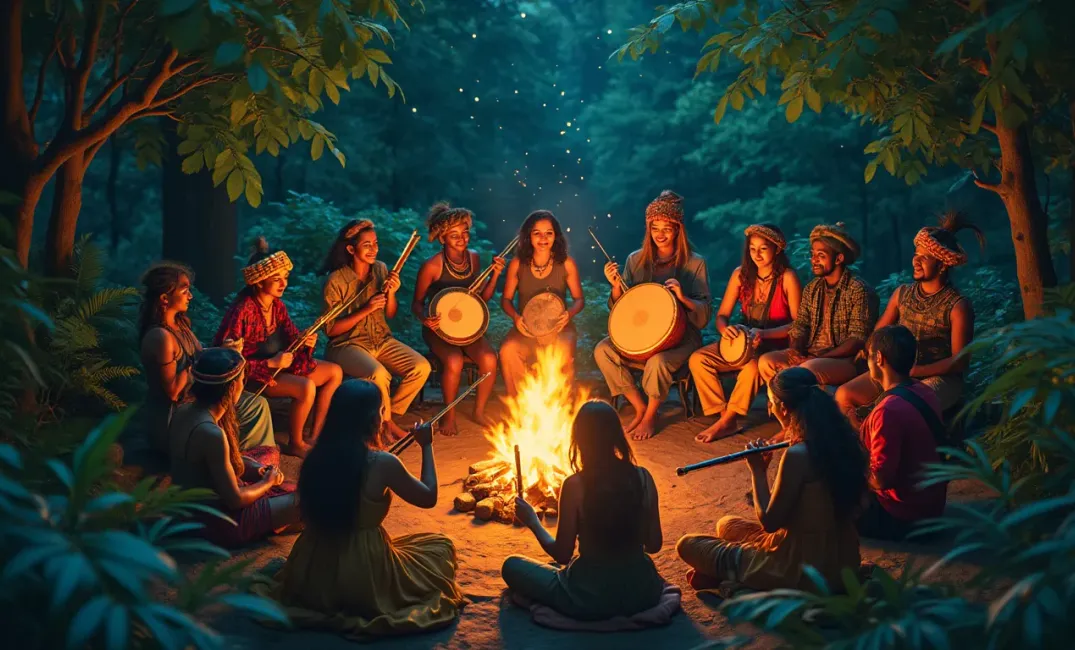Introduction: The Universal Language of Human Emotion
Music—a transcendent force—binds humanity through mysterious harmonies that resonate beyond the spoken word. It is an elemental form of expression, tracing aspirations and emotions across the corridors of time and space. From the primal beats of ancient drums to the digital compositions shared across cyberspace, music acts as both a historical tapestry and a vibrant catalyst for creativity and cultural unity. This entry explores humanity's relationship with music, its origins, evolution, and enduring impact across societies as both a mirror of the human condition and a guide toward a harmonious future.
"Where words fail, music speaks." — *Hans Christian Andersen*
The Origins of Music: Humanity’s Ancient Melody
Primal Echoes and Early Harmonies
- Natural Rhythms and Instruments: Music finds its roots in the natural rhythms of the world: heartbeats, footsteps, and seasonal cycles. Early humans crafted rudimentary instruments from materials around them, such as bones, stones, and hides, to create percussion and wind instruments. The discovery of ancient flutes made from bird bones and mammoth ivory in the Swabian Jura of Germany testifies to music's deep-seated presence in early human culture over 40,000 years ago.
- Rituals and Community: Music served as a powerful tool in communal rituals and celebrations. It connected individuals, offering a medium for storytelling, religious ceremonies, and community bonding. Drumming circles and chanting formed the backbone of rites in ancient cultures, from African tribal traditions to the spiritual ceremonies of Australian Aboriginal peoples.
Music in Ancient Civilizations
- Mythology and Divinity: In ancient civilizations, music was often associated with divinity and mythology. The Greeks believed that music was a gift from the gods, with instruments like the lyre linked to Apollo, the god of music and prophecy. Egyptians used music in worship and public gatherings, with musicians often depicted in tomb art, highlighting music's role in both life and the afterlife.
- Cultural Wealth and Influence: Across Mesopotamia and India, the development of musical systems reflected complex cultural tapestries. Babylonian cuneiform tablets reveal musical notation and tuning systems, while ancient Vedic chants in India illustrate the intertwining of music and spiritual practice. Music traversed boundaries, facilitating cultural exchange and enhancing societal integration.
Musical Evolution Through Epochs
The Classical Inspirations
- From the Medieval Echoes: The medieval era laid the foundation for Western music, with the rise of Gregorian Chants and polyphony shaping ecclesiastical compositions. Advances in musical notation allowed composers to preserve harmonic complexity, leading to the codification of sacred music across European monasteries and cathedrals.
- Renaissance Harmonies: The Renaissance period was marked by a flourishing of musical creativity, as secular music rose alongside sacred compositions. Composers like Palestrina and Josquin des Prez expanded on polyphonic textures, while innovative forms such as the madrigal began to take shape, showcasing emotions and humanist ideals through layered vocal arrangements.
Baroque to Romantic Transformations
- Baroque Brilliance: The Baroque era introduced dramatic expressions and ornamentation in music. Composers like Vivaldi, Bach, and Handel diversified musical forms while exploring contrast, tension, and harmonic boldness. The development of operas and oratorios expanded narrative capabilities, weaving stories through instrumental and vocal brilliance.
- Classical Clarity: The Classical period, under titans like Mozart and Haydn, sought balance and clarity, setting the stage for symphonic and chamber music's structural refinement. The era witnessed the rise of concertos, sonatas, and symphonies, with public concerts becoming cultural milestones that democratized music consumption.
- Romantic Expressions: Romanticism embraced emotional introspection and nationalist sentiments, allowing composers like Beethoven, Chopin, and Wagner to push musical boundaries. Their works expressed profound personal and cultural narratives, embracing both joy and anguish, reflecting the complexities of the human experience.
Modern and Contemporary Music: A Tapestry of Diversity
Jazz, Blues, and Cultural Revolution
- From Blues to Jazz: Originating in African American communities, blues music captured themes of hardship and resilience, while jazz emerged as a genre of improvisation and innovation. The syncopated rhythms and harmonious diversity of jazz celebrated cultural fusion and creative freedom, influencing global music landscapes.
- Cultural and Political Movements: Music became a medium for social change during the 20th century, with genres like rock & roll and folk music epitomizing rebellious spirit and activism. Figures such as Bob Dylan and The Beatles wielded music as a force for cultural reflection and societal transformation, encapsulating the zeitgeist of eras through melody and verse.
The Digital and Global Age
- Technological Integration: The digital revolution transformed music production, distribution, and consumption. Synthesizers, electronic music, and digital platforms expanded creative horizons, allowing for boundary-less artistic exploration. The rise of genres like electronic dance music (EDM) and hip-hop reflects technology's profound influence on musical innovation.
- Global Fusion and Hybrid Forms: Music transcends borders in the contemporary era, integrating global influences into hybrid forms. Collaborations between artists from varying cultural backgrounds result in vibrant fusions, enriching the world's musical tapestry. Streaming platforms connect audiences with an unprecedented variety of sounds, promoting inclusivity and expanding musical literacy.
The Impact and Significance of Music
Cognitive and Emotional Resonance
- Music and the Brain: Research demonstrates music's significant impact on cognitive development, emotional health, and memory. It stimulates neural pathways linked to emotional regulation and creative thinking, enhancing learning outcomes and therapeutic interventions.
- Emotional Expression and Healing: Music's emotional resonance provides solace and expression for individuals in times of joy or sorrow. Music therapy has become a recognized field, leveraging music's emotive potential to aid healing and personal growth across diverse contexts.
Music as a Cultural Bridge
- Cultural Diplomacy and Unity: Music acts as a conduit for cultural diplomacy, fostering understanding and peace across linguistic and geographical divides. International musical collaborations, concerts for global causes, and events like the Eurovision Song Contest illustrate how music unites individuals, fostering collective empathy and global solidarity.
- Preserving Heritage and Innovation: While preserving traditional forms, music also fuels innovation by inspiring new styles and experimental pursuits. It reflects cultural identities, capturing unique stories and values while continuously evolving to embrace contemporary narratives.
Conclusion: A Timeless Symphony
Music is an ever-evolving art form, a timeless symphony that encapsulates the essence of what it means to be human. It has the unique power to bridge the past with the present, to connect individuals with their heritage and with each other across distant corners of the globe. As societies advance, music remains a testament to human unity through diversity, an enduring legacy of our capacity for shared expression.
In the search for new worlds and identities, humanity finds solace in the notes and rhythms that compose the universal language of music. A language unrestricted by time and space—ever resonating, ever inviting.
"Music is the shorthand of emotion." — *Leo Tolstoy*
EVOLUTION, DIVERSITY, TECHNOLOGY, CLASSICAL MUSIC, HUMAN EMOTION, ANTHROPOLOGY, GLOBAL INFLUENCE, HISTORY, CULTURAL UNITY, MUSIC

